Gentlewoman Interiew with Tilda Swinton, Sally Potter & More
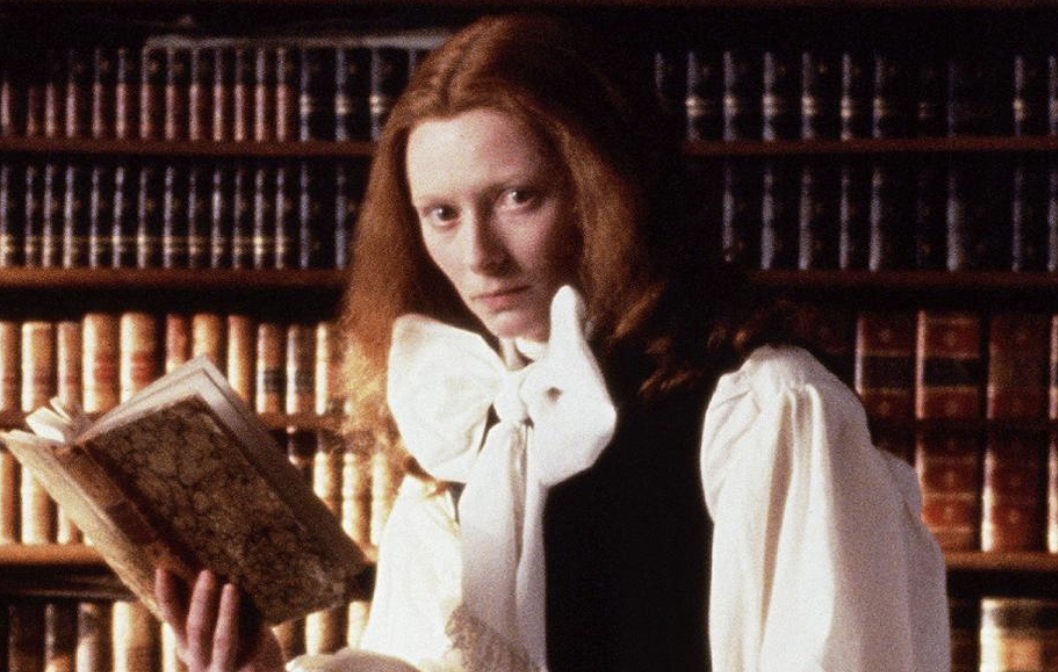
Sick of rejections from Hollywood’s bonnet-crazed bigwigs, Sally Potter set out to make a movie of Virginia Woolf's “unfilmable” novel Orlando on her own terms, decamping to the former USSR as the Iron Curtain collapsed. What sounds like a recipe for art-house obscurity yielded box office gold, presaging contemporary conversations about sexual and gender identity by three decades and launching extraordinary careers, not least that of a certain Tilda Swinton. As the film celebrates 30 years in print, here’s how a passion project became a landmark cinematic revelation.
The Book
Sally Potter: I met Tilda on a march in 1988. The 1980s was the decade of marches. Women’s marches, gay rights marches…
Tilda Swinton: I remember the exact spot in Hyde Park Corner. I was with Derek Jarman. Sally rang me up afterwards and asked me to tea at a cafe in Camden Town. Between us on the table she put down a book. It was a copy of Orlando. I didn’t say much, so she probably didn’t realise what it meant to me.
Sally: It was Cafe Delancey in Delancey Street. I remember this quality of shock in her.
Tilda: Orlando had been my most treasured book when I was a teenage poet. At boarding school, I used to sleep with it under my pillow.
Sally: For four years prior to meeting Tilda, I’d been studying Orlando and writing a treatment for the film. I’d reread the book multiple times, read all of Virginia Woolf’s diaries, plus everything I could find that could illuminate her writing of the book. And the more I delved into it, the more I found. Underpinning this celebration of impermanence, there are philosophical themes about the illusions of identity, about what is the present and what is the past.
Tilda: Sally had seen me at the Royal Court in 1988 in a one-woman play called Man to Man by Manfred Karge. It’s about a woman who disguises herself as her dead husband, who had been a crane operator.
Sally: But the real key for me to knowing that Tilda had the qualities for the role of Orlando was the 1987 film Friendship’s Death, because she was playing, if not an alien exactly, someone non-earthly. She had this still centre, and I realised she was someone who could receive the gaze of the camera not just with equanimity but with love. Tilda fed on being looked at. Strangely, not every actor does.
Allison Adler Inglis-Taylor: Vita Sackville-West’s son Nigel Nicolson famously described Orlando as “the longest and most charming love letter in literature”. It encompasses everything Woolf found attractive and intriguing about Vita, this wealthy aristocrat and diplomat’s wife with whom she enjoyed a short affair and a deep and enduring friendship. Woolf was very interested in the relative sexual freedoms that were afforded to noblewomen like Vita.
Sally: The book doesn’t speak to my class background at all. My father was an anarchist, and I grew up left-wing, very poor. I’d been on the road as a singer in a group called FIG, which was an acronym for Feminist Improvising Group, and I’d made several short films and one feature. Christopher Sheppard: I met Sally at the Moscow Film Festival in 1987. I was a documentary filmmaker, and Sally was there shooting material for a Channel 4 programme about women in Soviet cinema. It’s hard to comprehend now, but there simply were no women film directors back then. When Sally made The Gold Diggers, starring Julie Christie, in 1983, it was the first British feature written and directed by a woman that had been seen in cinemas for nearly 30 years.
Sally: By the late 1980s, there were already a lot of what I call “bonnet pictures” that were happily reinforcing the myth of heritage with no mention of where all the money came from to pay for the manicured lawns, great costumes and enormous houses — namely colonial rape and pillage. Inspired by Virginia Woolf’s use of wit and irony, my film of Orlando was going to be a critique of all of the above. But lightly done.
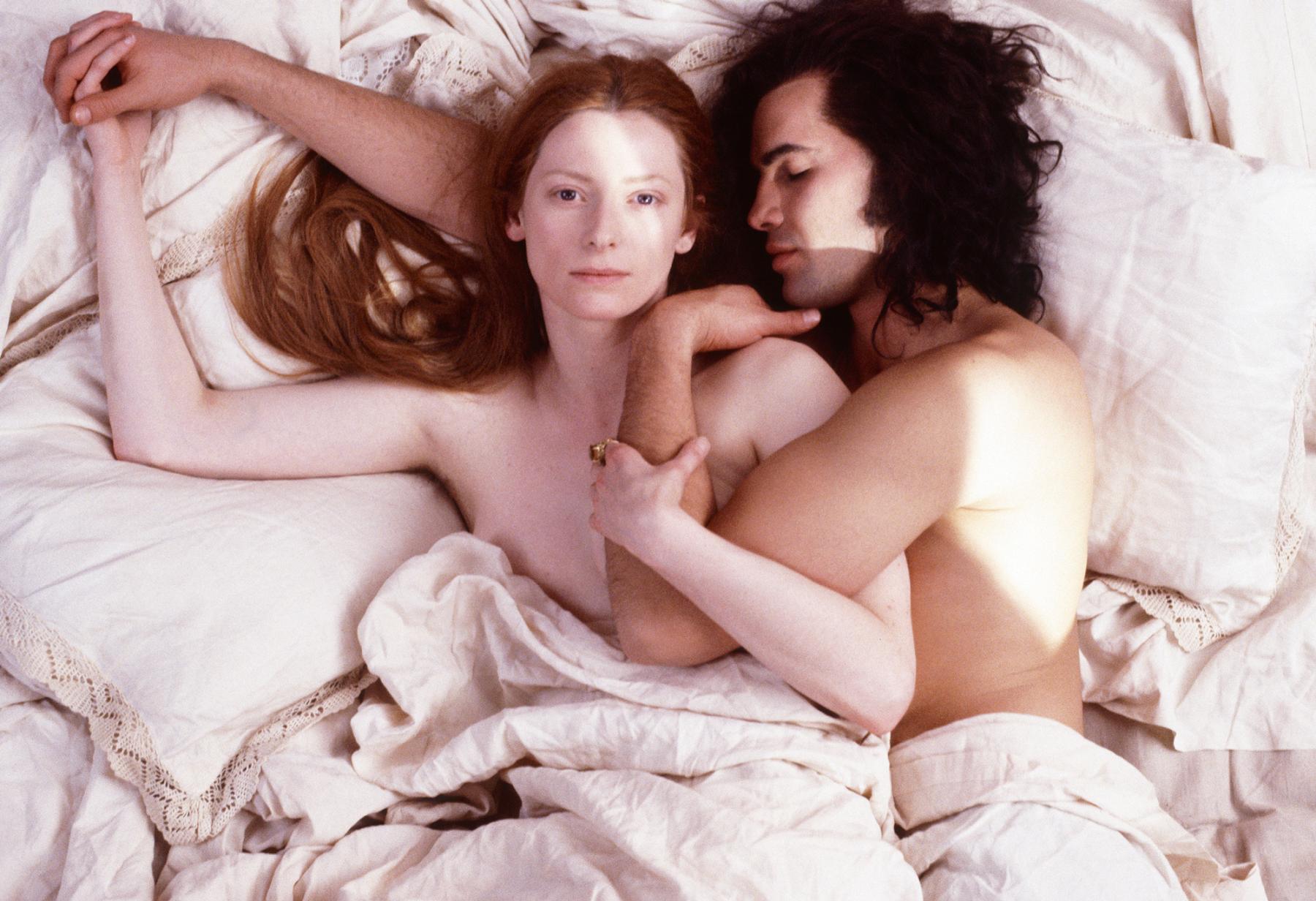
Tilda Swinton with Billy Zane as Shelmerdine, a fantasy character who Virginia Woolf may have based on Vita Sackville-West’s husband, Harold Nicholson.
Vision
Christopher: The big puzzle was the budget. Sally knew that for Orlando to work it had to work on an epic scale, because the premise is so preposterous — this is someone who lives for 400 years and changes sex in the middle. When I came on board, I had meetings with the established production managers and producers. Immediately they were saying, “This needs a budget of £10 million or more.”
Tilda: We went all around the houses looking for funding. I remember a fancy cocktail party in an apartment on the Upper East Side of Manhattan that someone hosted for us on the condition that I would read aloud chapters from the book. We didn’t raise a penny. Not one dime.
Sally: We were staying in a tiny borrowed place on the Lower East Side. Tilda slept on the sofa bed, and it was like a range of mountains; it was so uncomfortable.
Tilda: We had lists of all the people we were going to hit up for money. People were saying to us: “A costume film — for who? Why? What?” They couldn’t imagine beyond the sort of Merchant Ivory Victoriana.
Allison: Merchant Ivory encapsulates a quietness in English life and character that EM Forster is so good at capturing. But Woolf resists the easiness of nostalgia, not least through all the discontinuities in Orlando’s character him- or herself.
Sally: I have a letter from the head of an American studio saying, “Not only can this film never be made, it never should be made.” Once my folder of rejection letters got very fat, I thought I would have to somehow show people what this film will be.
Tilda: We decided what we needed is what’s now called a deck. I said, “Well, I went to school with a Sackville-West so I could ask if we could do a photo shoot at Knole.” We pooled our money and hired two costumes: a pink Victorian lady’s dress and a brown velvet boy’s doublet and hose. And we went down to Knole in my little car, and I sort of ducked behind a hedge and changed, and Sally took these photographs of me draping myself over walls and up against doors.
Sally: I took the photographs to a Xerox shop, stuck them alongside some texts and made 100 books by hand.
Tilda: It was absolutely beautiful: a hardback, gold-embossed book with these photographs and our biographies and Sally’s idea of what the film was going to be like.
Christopher: There was also a meeting with Harvey Weinstein, who had distributed My Left Foot, which had just won an Oscar. Sally I literally made an elevator pitch, and I think Weinstein said something like, “I admire your guts,” and that’s as far as it went.
Collaboration
Christopher: Sally’s vision — the film she had in her head since she read Orlando — included incredibly ambitious things, in particular a frozen River Thames.
Sally: The ice scenes were crucial, because they’re near the beginning of the story, and I wanted to see people really skating.
Christopher: I said, “So let’s go to somewhere where there’s real ice. Let’s go east.”
Tilda: Sally and Christopher went on that first recce to the USSR to look for locations for the frozen sea, and when the people helping them asked what the film was about and they said, “It’s about immortality and history and capital and collective action,” they said, “Yeah, we get that! We’d like to be partners.”
Alexey Rodionov: It was the time of perestroika, and Russia was of fresh interest to the West. Sally had meetings with several cinematographers, including me.
Christopher: We started to think: What if we can shoot the whole film over there? We went through several possible Russian partners, including an oligarch who had a four-storey house on a square behind Harrods.
Sally: We made something like 30 visits to the Soviet Union, mostly to Russia and Uzbekistan. I was in a constant state of jet lag and hope and disappointment. Christopher: When Sally’s photographs of Tilda at Knole were combined with some of the Russian and Uzbek locations, people could see this wasn’t just some parlour game. We had one of those big zip-up portfolios for Sally’s collages, which we called the fucking folder.
Sally: The fucking folder got traipsed along from one meeting to another. It got left behind regularly in the overhead lockers of planes or on the train.
Christopher: The big breakthrough was a change of personnel at British Screen in 1991. The predecessor to the BFI 3 Production Fund had consistently turned Sally and the project down. Its new boss, Simon Perry, was a believer, and he is the one person, in terms of funding, without whom Orlando would never have been made.
Simon: Perry When I came to British Screen, I did so on a strongly European ticket, minded to encourage directors to supplement the money they got from us with money from Europe rather than America.
Tilda: It all started to snowball after that.
Christopher: When we went to Cannes the second time looking for funding, I met the person who became our Dutch co-producer, Matthijs van Heijningen, who still has a little art-house cinema in Amsterdam called The Movies. He had a Rolls-Royce and smoked cigars. I showed him the fucking folder.
Matthijs van Heijningen: I was attracted by the ambition. My partner, Guurtje Buddenberg, and I were the first co-production company to come in before France, Italy and Russia. By coincidence, Sally and Christopher were insisting on the Dutch production-design partnership Ben van Os and Jan Roelfs because of the work they had done on Peter Greenaway’s films, including The Cook, the Thief, His Wife and Her Lover. We had worked with Ben and Jan on an adaptation of the Dutch 19th-century novel Eline Vere. So the six of us came together on Orlando.
Sally: The design team, Ben and Jan, were absolutely perfect. Sandy Powell wrote me a note, and of course I already knew her and the brilliant work she’d done with Derek Jarman. Valerie Steele: The scenography and costumes are absolutely essential to this film, because they make Orlando’s time travel immediate and intensely visible — like a dream.
Christopher: It felt precarious — and it was — putting together this patchwork of European funding. But it was also liberating. Because no single entity was writing the one big fat cheque, no one felt like they owned us. Once we had enough money to get that core crew on a plane to Russia in February 1992, that’s when I felt, They can’t stop us now.
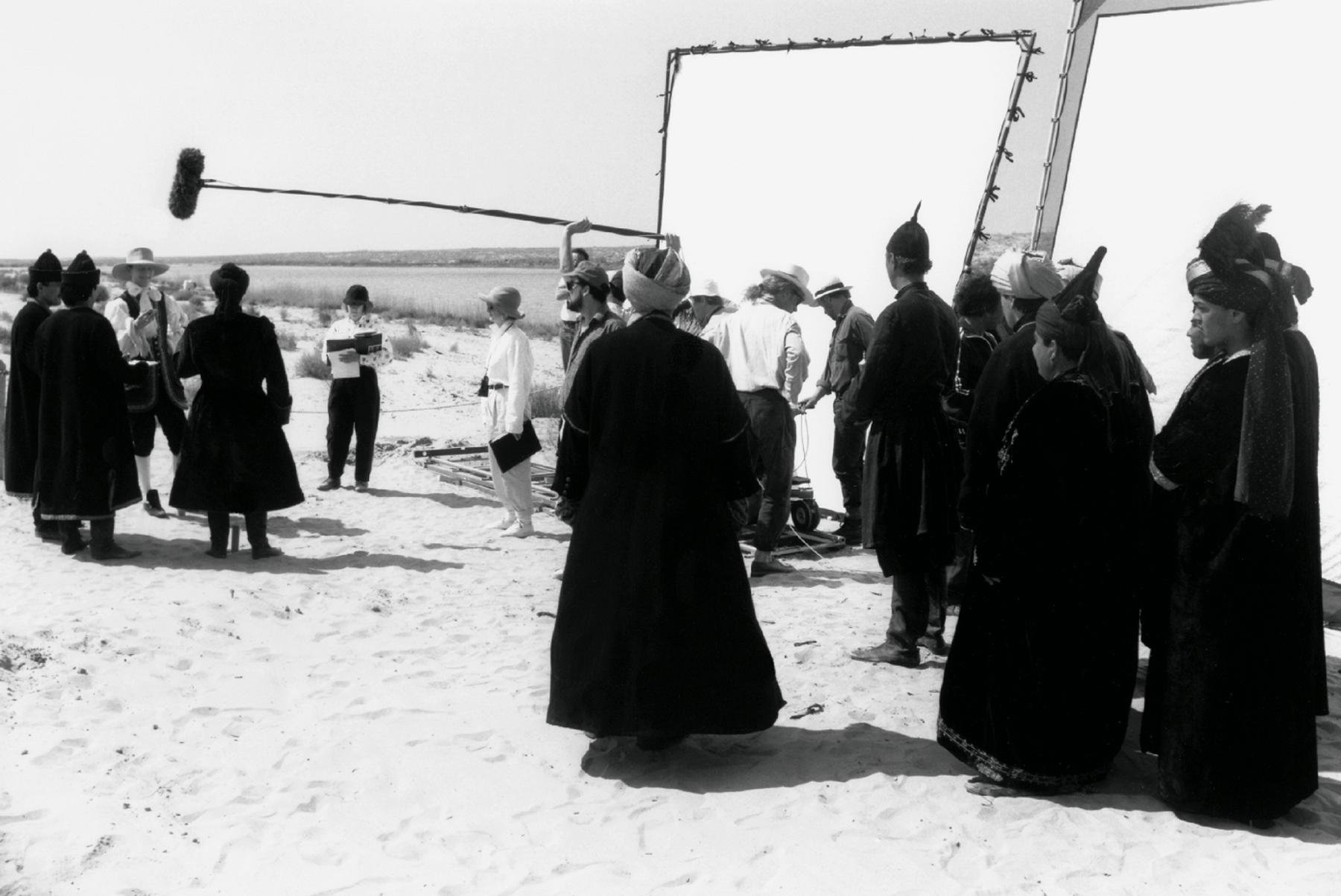
Shooting the desert banquet with Tilda Swinton and Lothaire Bluteau in Khiva, Uzbekistan. Sally Potter is with the script supervisor, Penny Eyles, and a hard-grating crew.
The Locations
Renny Bartlett: There was a naive utopianism to what we were doing, despite history and the Cold War and all that.
Christopher: Clearly Russia could deliver tremendous production value — our money went 50 times further than it would have in the UK — but it was a bit like the Wild West: people who’d lived entirely under Soviet communism were working out how to be capitalists.
Valerie: The fact that Orlando is structured around distinctive eras — winter in the Elizabethan era, the Ottoman Empire, 18th-century London and so on — plays a crucial role in the narrative of an individual who lives for centuries in wildly different milieux. It holds together in part because this is no more unbelievable, in a way, than Orlando’s change of sex.
Christopher: The Olde London scenes were mostly shot in and around Lenfilm studio in St Petersburg, including an ice rink, where the banquet scene was shot. But Orlando’s house plays a big part in the story and is revisited repeatedly from one century to another.
Allison: The idea of Knole having had so many illustrious inhabitants was important to Woolf and Sackville-West, and both were distressed at the prospect of that history coming to an end because of Vita being disinherited on account of her sex.
Christopher: Early on we tried to make this place Marfino — a grand house 20 kilometres outside of Moscow — into an Elizabethan house. Trying that in the snow was a mad endeavour, but we kept going back. I remember Sally’s assistant, Renny, holding up fake grass and talking with Jan Roelfs about how to restore the brickwork. Eventually we realised: There’s no way we can do all of this here — we’re going to need a real house in England.
Allison: Hatfield House has a relatively understated aesthetic. Like Knole, it has the air of having belonged to civil servants, people who felt very dutiful towards the monarch and the state and would run their household accordingly.
Alexey: The most exciting scenes for me were in this strange place. It has an ancient mosque that’s underground and supported by a forest of wooden columns. The light comes in from above, and it seems to be the architectural expression of the idea that, as individuals, we count for nothing.
Christopher: There was something magical about Khiva. It didn’t have to be restored, it just needed to be dressed as an ancient city on the Silk Road —a perfect alternative for Constantinople.
Christopher: But to get permission to film there, we had to be on the right side of the local power elite, and that required the giving of various backhanders and gifts.
Renny: In terms of Western consumer goods, boom boxes were the big thing at the time.
Sally: We took the mayor of Khiva a stereo system, and he took us out into the desert, where he had set a table covered in food and a lot of bottles of vodka under the burning sun. And there we stood — for hours — exchanging toasts. “To your British film industry!” “To the great film industry of Uzbekistan!” “To international cooperation in the name of cinema!” and so on.
Tilda: Oh my Lord, it was really intense. Every time anyone spoke you had to down a glass of vodka as if it was water. We were so pie-eyed by the end of it. I thought, What are we going to be signing?
Christopher: The arrangement was that our fantastic Russian fixer, Zamir Gotta, would surreptitiously top up my cup with water so I didn’t get too drunk. This was noticed, and our hosts got terribly offended. Everyone got food poisoning the next day.
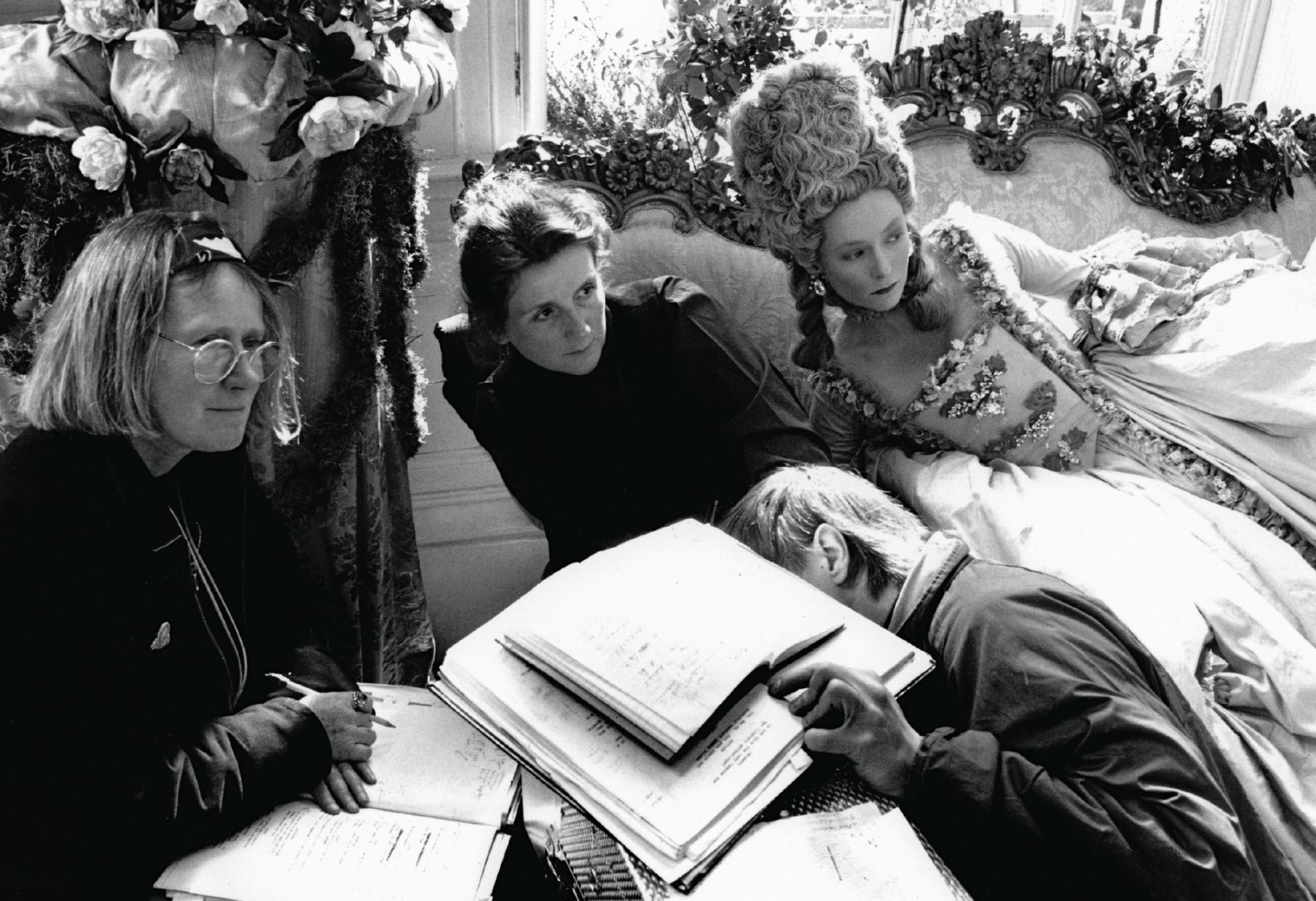
Based on a book and eight years of research, the script for Orlando was constantly revised. Here, Penny Eyles, Sally Potter and Tilda Swinton gather between scenes.
Casting and costumes
Christopher: Because of the funding set-up, we had to satisfy different agendas. As it was a French co-production, we had a French actor, Charlotte Valandrey, playing the Russian princess; likewise, there’s the Dutch actor Thom Hoffman playing King William, who only appears in one short scene with a bunch of tulips. We shot that at Blenheim Palace.
Tilda: All the dames of the realm had been proposed to play Elizabeth I...
Sally: I chose Quentin Crisp because I thought, He’s the true queen of England.
Sandy Powell: I had to go to New York to meet him and take his measurements in his tiny little apartment. He was frail, and in retrospect I feel incredibly sorry for him because the costume we made weighed a tonne and he had to sit down most of the time, poor thing.
Sally: I had worked out a colour palette for each sequence which came from Virginia Woolf; there’s a paragraph in the book talking about the golds and reds of the Elizabethan period, the purples and browns of the Victorian period.
Sandy: People think of it as a period film because it jumps through decades and centuries. But Tilda was wearing Wolford tights with her Elizabethan outfits at the very beginning. I didn’t think twice about whether it was right for the period — that’s just what worked with the costume.
Christopher: The costume department was in Julie Christie’s flat. She had become close to Sally after The Gold Diggers, and they got together to find a developer to turn a derelict shoe factory in Shoreditch into affordable live/work spaces for artists. Julie lent her space to us, and that is where the costumes were made.
Tilda: Sandy did the extraordinary costumes with that modernist attitude of maybe making 18th-century pannier dresses out of very cheap saris from Brick Lane market.
Sandy: It was always going to have an element of stylisation because of the way the script was written.
Richard Brody: The best literary adaptations are ones in which the filmmakers create a style as refined as that of the writers; Sally Potter does so, and comprehensively, with drama, image, production design and performance all conceived as if from scratch, from the ground up, without recourse to familiar modes.
Sandy: Tilda has a deep understanding of character, but she’s also a fantastic body to put clothes on.
Valerie: The film is difficult to imagine without Tilda Swinton, whose extraordinary androgynous beauty makes her “pass” as both male and female. I feel certain that her role in this film also helped make androgyny fashionable throughout the wider culture.
Action
Sally: After eight years, there was suddenly this quick, tense sprint of a shoot — 10 weeks!
Matthijs: The entire art department had left Amsterdam for St Petersburg in trucks full of every conceivable type of equipment, right down to screws and nails. I should say that not a single nail came back.
Tilda: Something that’s quite magical about the film is that it predates any of that CGI.
Renny: We used Russian technology from the 1930s! London Bridge is a three-dimensional hanging model placed in front of the camera.
Tilda: The list of things we had to take with us to St Petersburg was very long: any medicine you might possibly need, foodstuffs — and a bath plug. Of course, some of us were better campers than others.
Sandy: I had to keep the costumes in my hotel room, pack them into suitcases and drag them in to work every day and then put them on the actors and hope the creases would drop out. I mean, it was very primitive.
Christopher: Sally was revising the script all the time. There’s a wonderful photo of Walter Donohue, the legendary editor, sitting on a box on the ice rink in St Petersburg where the banquet scene was shot, retyping the script on his little Olivetti typewriter.
Walter Donohue: The script always had a solid structure, buttressed by the source material: Woolf’s novel. However, when there are harsh climate conditions, like a winter in St Petersburg, the script inevitably needs to adapt.
Sally: Meanwhile, I was in terrible debt from paying for the rights to the book and keeping going with the development. The bailiffs came during the shoot. We couldn’t talk about it. All the cast and crew knew was that they were working unbelievably hard under unbelievably difficult conditions for virtually no money.
Renny: While everyone else went back, I was sent to Khiva to conjure a unit in Uzbekistan out of nowhere and turn a decaying caravanserai into a viable hotel.
Zamir Gotta: My cousin was a famous filmmaker in Uzbekistan, so I pulled in the favours. My main job was to tone down aspects of the film — from the exuberantly gay Dutch production design team to a woman exposing her breasts — in my representations to the wider Muslim community. I’d circulate my own edit of the script with no mention of nudity. I learned a lot on Orlando about how it is to be the intermediary between different cultures. It set me up for a lifetime of Hollywood fixing.
Christopher: In Alexey, Sally had a genius cinematographer, but he was not at all used to the rigours of Western filmmaking — making a film in 10 weeks when his previous one had taken nine months. His view was that this was the worst of capitalism’s brutality, to subject artists to that kind of pressure.
Sally: Alexey was economical with praise, but if there was a shot he liked, he would say “it’s not disattractive.”
Alexey: Technically, it felt disastrous. We went to Uzbekistan for the hot sun, but it was raining all the time.
Renny: All shoots are tough, but this was particularly tough because we were working all day, then switching immediately to night scenes. Everyone was perpetually exhausted, having got three hours’ sleep night after night after night. As a crew member you’d quite often do double duty as an extra. I was forever having to pull on some outfit or other.
Sally: I learned a great deal during this film about daring not to be liked. I found it very uncomfortable because, like everybody, I want to be liked and loved.
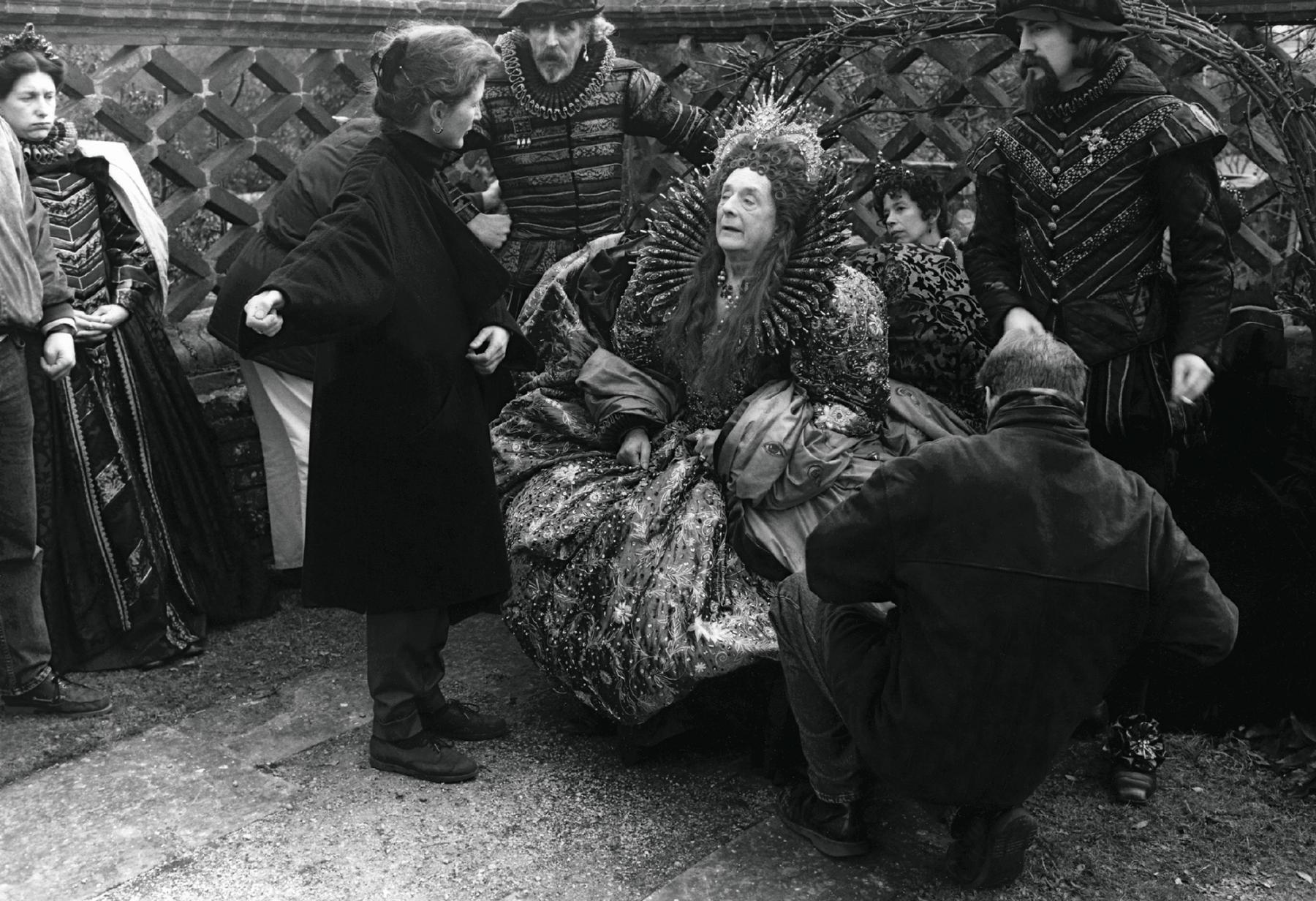
Sally Potter directs Quentin Crisp as Queen Elizabeth I, who delivers her final lines to Orlando: “Do not fade. Do not wither. Do not grow old.”
Editing and reshooting
Christopher: Very early in shooting, Charlotte Valandrey had a kidney infection and had to return to Paris to see the doctors, so that knocked a huge hole in the shooting schedule. But it turned out to be a blessing. The insurance payout allowed us to go to Pinewood Studios to reshoot her scenes. We made that studio time go a long way. It wasn’t just the scenes in which Tilda walks through First and Second World War battlefields that we were able to shoot but also Orlando standing on the bridge over the river looking at the people standing on the broken ice — that’s the tank at Pinewood. And we added the oak tree at the end, with Jimmy Somerville returning as the angel.
Sally: As my editor, I chose Hervé Schneid, who had cut Delicatessen in sharp, short bursts, as a deliberate contrast to my own, more lingering sensibilities. I sat next to him in the cutting room at Goldcrest in Soho and bit my tongue, knowing that the tension between our approaches would create a dynamic energy in Orlando.
Christopher: Already the shots were choreographed in very fine detail. Say the Orlando character is having tea in the Victorian drawing room with Shelmerdine, played by Billy Zane. If you look at the camera, it’s mostly one complicated track, which took hours to get right. This drove some of the more conventional people in the crew crazy.
Sally: You’re expected to do a wide shot, a medium shot, a close-up, plus several others, maybe. Then in the cutting room you decide which of those angles you’re going to use. It’s called having coverage, and it tends to result in a very conventional visual language. I never wanted coverage. I wanted to fully commit to the essence of each scene. When I saw how episodic it was in the cutting room, I decided to turn this to advantage by adding title cards. I thought: if people want to know what date it is, here’s the date. And a theme: death, sex, politics, et cetera.
Allison: That kind of signalling is there in Woolf’s novel, too. At the beginning of each section she provides meticulous descriptions of the physical world that signal time and place.
Christopher: We were in the last stages of editing the sound and mixing at Twickenham Studios when Sally told me she’d been awake all night thinking about what to do about music.
Sally: I could hear the music in my head; I wanted this feeling of ghostly voice. I went to David Motion’s underground studio in Soho and multitracked my own voice. I tried to become a semi-audible choir, but I didn’t want anyone to know it was all me.
David Motion: I’d been a record producer in the 1980s, making techno-pop with a classical sensibility — I’d borrow a bit of Sibelius’s Symphony No 5 for Strawberry Switchblade’s “Since Yesterday”, that kind of thing. More recently I’d been writing music for commercials, so I had experience with writing music to picture. I’d get musicians in — people like Alexander Balanescu, the Romanian violinist — and we’d put them in the sampler and muck about with the tuning.
Allison: Jimmy Somerville was an inspired choice, appearing as an angel in the scene which brings us right up to the 1990s, where female Orlando sits under an oak tree, watching a young girl play with a camcorder.
David: He had a terrible cold when we recorded that. Subsequent versions just didn’t have the same magic, so we used the first version. Allison: In a funny way, Jimmy Somerville has a lot in common with the way Orlando works, constantly mixing up times, doing cover versions in the way that Virginia Woolf loved to do cover versions of earlier literature.
Sally: I wrote the 1990s scene in which Orlando takes her manuscript to the publisher during the edit, because I had to find the right way to end the film after rejecting several others I had already shot.
Valerie: Virginia Woolf ended the story in her time, Sally Potter in our time. By bringing the story up to the present, it becomes more real to us.
Allison: Both Woolf and Vita Sackville-West found the idea of bringing history into the present moment very compelling. The film begins in the Elizabethan period, where gender fluidity was pretty normal, and then you get to the Victorian period, where gender has become completely congealed, and then in the 1990s present moment, the boundaries have become more fluid again. There’s a definite sense that the more constricting the clothes become, the more restricted women become.

Jimmy Somerville is raised aloft by crane for the final scenes, in which Orlando has vision of an angel singing to her.
Reception
Christopher: Orlando was selected for Venice based on the working print.
Sally: It had been shown to nobody. I was still working on the sound mix in the days before the premiere. There was a screening for press, then a press conference before the public premiere on the same day. We were told there’d been a lot of applause at the end of the press screening and that this was very rare. When we walked into the press conference, we got this huge standing ovation.
Tilda: I remember Sally and I being like rabbits caught in headlights, because we’d been pushing this thing up a hill for so long without really thinking about the audience at all.
Sally: We were just kind of looking at each other and saying, “They seem to have liked it.”
Matthijs: In almost 40 years of producing feature films, the premiere of Orlando was one of our best ever.
Christopher: The reviews were fantastic. I walked around the back of the hotel, the Hotel des Bains on the Lido, and Carole Myer — this legendary sales agent that Simon Perry had brought on board — said to me, “Christopher, you’ve got a hit.”
Richard: That against-the-grain tracking shot, keeping a cool distance from Tilda Swinton’s cool gracefulness and seemingly framing the voiceover, made it apparent to me from the very start that this was going to be a masterwork. And any doubt was dispelled in seconds with the second shot, the close-up in which Orlando breaks into the monologue and breaks through the scene.
Sally: As a writer-director, a film is a world you carry around in your head for a very long time. Once it’s out, that world starts to disintegrate and take on new lives, and you see, Oh, it’s had this effect on this person, and this country sees it in this way. And you see the effect it has on you when you’re fronting up your own work later.
Zamir: Sally and Christopher invited me and my wife to the premiere in London. Jimmy Somerville performed live on stage at the after-party. It seemed to me that we were celebrating a unification. A unification of spirit and intellect.
Sally: In London it was number one at the box office. Number one! It was mentioned in the ITV soap opera Crossroads, with one of the characters saying, “Have you seen that Orlando?” And I said, “OK, that’s it. That’s the sign of approval.”
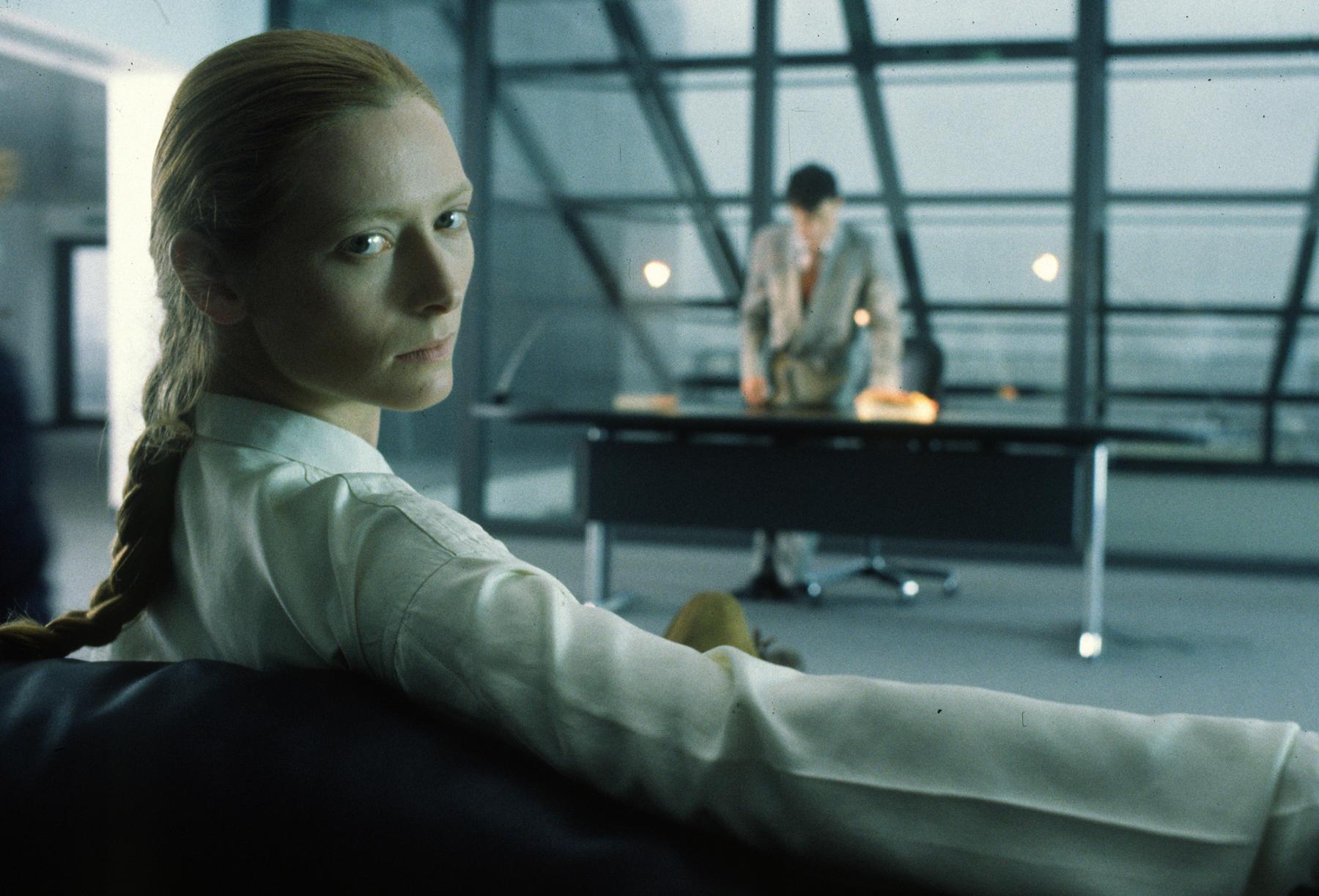
The “right way to end the film”: Orlando takes her manuscript to the publisher, played by Heathcote Williams, who earlier played the poet who mocked Orlando’s poetry.
Legacy
Sally: I was 43 at the time Orlando was released, I’d already had a couple of decades of professional life. But I’d always been an outsider, always part of the counterculture. With Orlando, I felt myself cross over into… if not exactly mass appeal, then so-called success.
Sandy: I saw it on the big screen recently, and it’s truly remarkable. Sally was so brilliant to conceive it and bring it all together.
David: To this day I admire her single-mindedness in achieving it — even though things were pretty hairy towards the end.
Alexey: I teach film these days, and students — Russian 20-year-olds! — know this film and like it.
Tilda: It was fairly torturous, I have to say, but I’m all for the long gestation period. Orlando gave me the confidence to know that I could make more films and try to go down the same track. And now I have these longstanding relationships with Luca Guadagnino, with Bong Joon-ho, Jim Jarmusch, Joanna Hogg…
Richard: Free minds and uninhibited creations are always inspirations — and, above all, the sensibility that Tilda Swinton embodies has flourished throughout her career and throughout the world of movies and has set a tone for acting to which many other directors and performers have tuned themselves.
Allison: Given it came out 30 years ago, Orlando is almost bizarrely prescient — completely switched on to the present set of concerns that people have about their identities and how fluid they are.
Renny: It’s sex-positive, it’s gender-positive and it’s historically positive. It’s such a positive film. That’s not to say we didn’t go through shit to make it.
Sally: I’d like to think that if I made it now it would have the same sense of optimism.
read piece here: https://thegentlewoman.co.uk/l...